African violets are popular flowering plants that bloom throughout the year. African violets are easy to care for, but they can face various problems if they face unfavorable conditions.
Due to improper care, the leaves of your African violets can start turning brown. So, in this article, we shall discuss why are my African violet leaves turning brown?
Underwatering and Overwatering are the primary cause of brown leaves in African violets. Underwatering often leads to drooping, dry, and parched soil resulting in brown leaves. Whereas overwatering often leads to brown spots and diseases, resulting in brown leaves.
Many other reasons can also make your African violet leaves brown, like improper lighting, low humidity, improper fertilization, nutrient deficiencies, poor soil, pest problems, and temperature change.
With that said, Incorrect watering is the most common reason due to which your plant shows brown edges on the leaves. You need to provide your plant with proper care for resolving this problem.
This article will comprehend why your African violets turn brown and how you can carefully treat this issue.
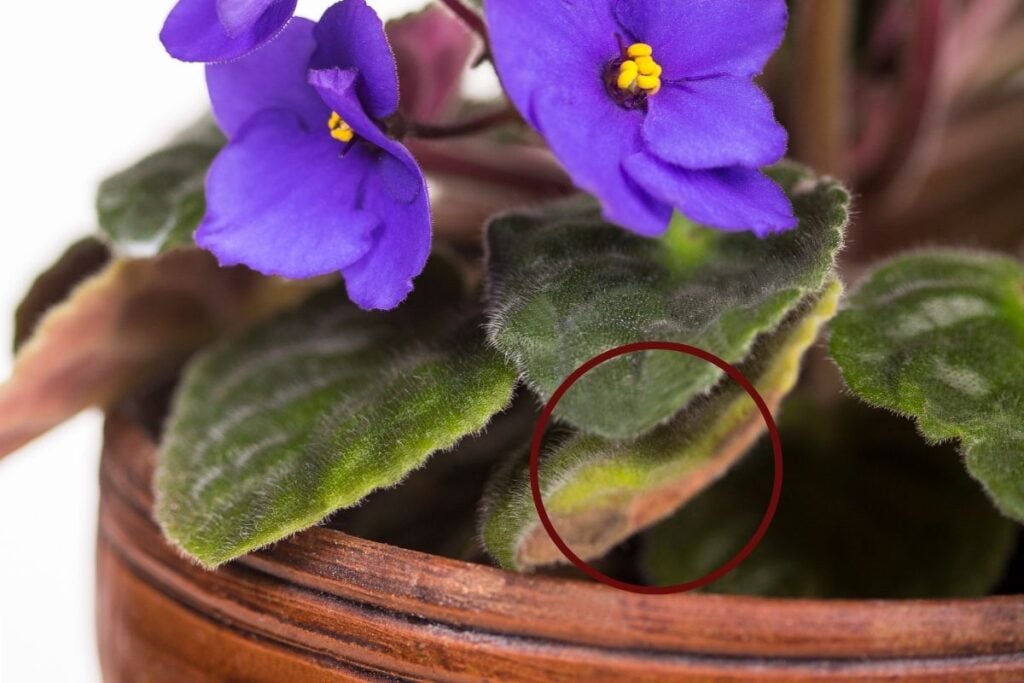
Causes of brown leaves in African Violets
African violets struggle with different problems, which can lead to brown leaves. There are various reasons which make it difficult to understand why your African violets are drooping and turning brown.
Let us discuss the causes for the brown leaves in African violets.
- Inadequate watering
- Overfertilization
- Low light
- Too much heat
- Low humidity
- Poor air circulation
- Root rot
- Pest infestations
Overwatering
Overwatering might be the reason behind brown leaves on your African violets. These plants don’t like to sit on water for an extended period as the soggy soil can adversely affect their growth.
When you water your plant too often, you allow diseases to grow in the soil, which can cause root rot.
African violets need a good level of moisture but up to a limit. Due to excessive water, all the air pockets in the soil get jammed, and the roots fail to get enough oxygen to breathe, which can kill the entire plant.
It mainly happens when the African violets are planted in poorly drained soil or if the plants are standing in water for too long.
Solution
You can follow the steps given below to make sure the African violets are not overwatered.
- Check the soil’s moisture level before watering your African violets.
- Stick your finger 1-2 inches inside the soil and check the tip. If the soil feels wet, the soil has enough moisture, and you should stop watering immediately.
- Provide at least 4 hours of indirect sunlight to prevent overwatering.
- Remove the dead and dying roots and keep only healthy ones.
- Create an additional space between the roots to allow oxygen to reach the root zone.
- Water your plants after the topsoil get dry. If the weather is moist and humid, avoid watering for few days.
Underwatering
African violets like to stay in a moist condition, so the soil should not be completely dry. If the soil gets less water, the plants will not get enough moisture or nutrients.
The leaves get dehydrated and turn brown, and also begin to droop if it stays without water for an extended period. It is crucial to water them adequately to keep them healthy and moisturized.
Solution
To resolve the problem of underwatering, you can follow the steps which are given below.
- Water your African violets every other day if your plant is dehydrated.
- Ensure to thoroughly soak the soil when you water your African violets and let the excess water drain.
- Avoid excessive heat as hot conditions or warm drafts can significantly increase evaporation from the soil.
- Check the soil every few days to understand if your plants need water.
Also read: How Often Should African Violets Be Watered? (African Violet Water Requirements)
Looking for gardening supplies? We have tested 100's of products before recommending them to you guys. Check out our best pick below:
| Image | Gardening Supplies | Best Price? |
|---|---|---|
 Top
Top Top
Top | Raised Garden Bed Kit | Check On Amazon |
 | XLUX Soil Moisture Meter, Plant Water Monitor, Soil Hygrometer Sensor for Gardening, Farming, Indoor and Outdoor Plants, No Batteries Required | No Results |
 Top
Top Top
Top | 82 Pcs Garden Tools Set and Extra Succulent Tools Set | Check On Amazon |
 | Joeys Garden Expandable Garden Hose with 8 Function Hose Nozzle, Lightweight Anti-Kink Flexible Garden Hoses, Extra Strength Fabric with Double Latex Core, (50 FT, Black) | No Results |
 Top
Top Top
Top | Dual Chamber Compost Tumbler | Check On Amazon |
 Top
Top Top
Top | Sunnyglade Plant Stakes | Check On Amazon |
 Top
Top Top
Top | Organic Cold Pressed Neem Seed Oil | Check On Amazon |
 Top
Top Top
Top | Mighty Mint Gallon :-Insect and Pest Control Peppermint Oil | Check On Amazon |
 Top
Top Top
Top | Scotts DiseaseEx Lawn Fungicide | Check On Amazon |
 Top
Top Top
Top | Jacks Classic 20-20-20 All Purpose Fertilizer | Check On Amazon |
 Top
Top Top
Top | 30,000 Seeds Pollinator Attracting Wildflower Mixture | Check On Amazon |
 Top
Top Top
Top | Survival Vegetable Seeds Garden Kit-Over 16,000 Seeds | Check On Amazon |
Low light
Insufficient sunlight can also cause brown tips on the leaves of the plant. African violets love to get indirect sunlight daily to grow well.
If they don’t get enough light, the plant’s leaves can turn brown and droop. This happens because the process of photosynthesis reduces due to a lack of light.
African violets thrive best when growing in a place with a lot of indirect sunlight.
Solution
- If your African violets are growing in a location with poor sunlight, you should move them to another location where they will get at least 4 to 6 hours of indirect light.
- Try to remove the obstacles that are blocking the light.
- You can also use artificial lights such as grow light, LED, etc., inside your home.
Also read: What Kind Of Light Does An African Violet Need? (African Violet Light Requirements)
Too much heat
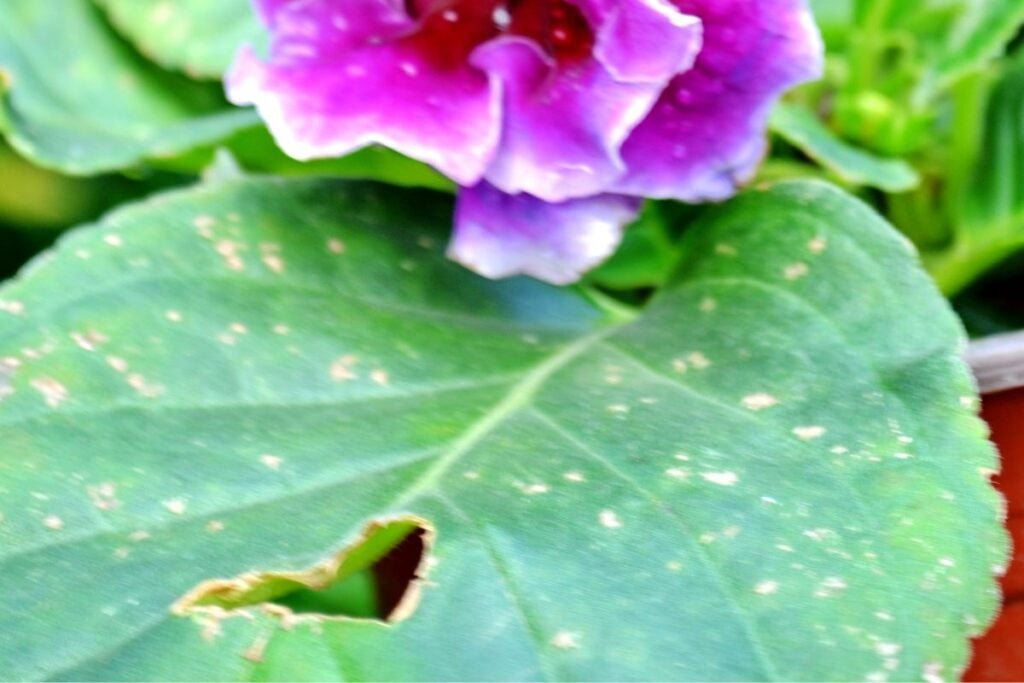
Extreme heat can also be a reason for brown leaves in your plants. If the African violets get exposed to the sun for too long, it can cause sunburn.
Browning, drying, curling, and falling leaves are the common symptoms of too much heat and sunlight.
African violets cannot tolerate direct sunlight and too much heat. Excess heat hampers the growth and causes moisture loss which turns the leaves’ edges brown.
Exposing these plants to direct sunlight can be deadly, so proper care and special attention are required.
Solution
- Cut all the brown leaves which are already damaged and cannot be recovered.
- Move your plant to a shaded area.
- Avoid sunny spots to protect your plant from direct sunlight.
- Provide a proper watering schedule. Keep the soil slightly moist all the time.
- Mulch the soil’s surface to keep the soil moisturized for a more extended period.
Overfertilization
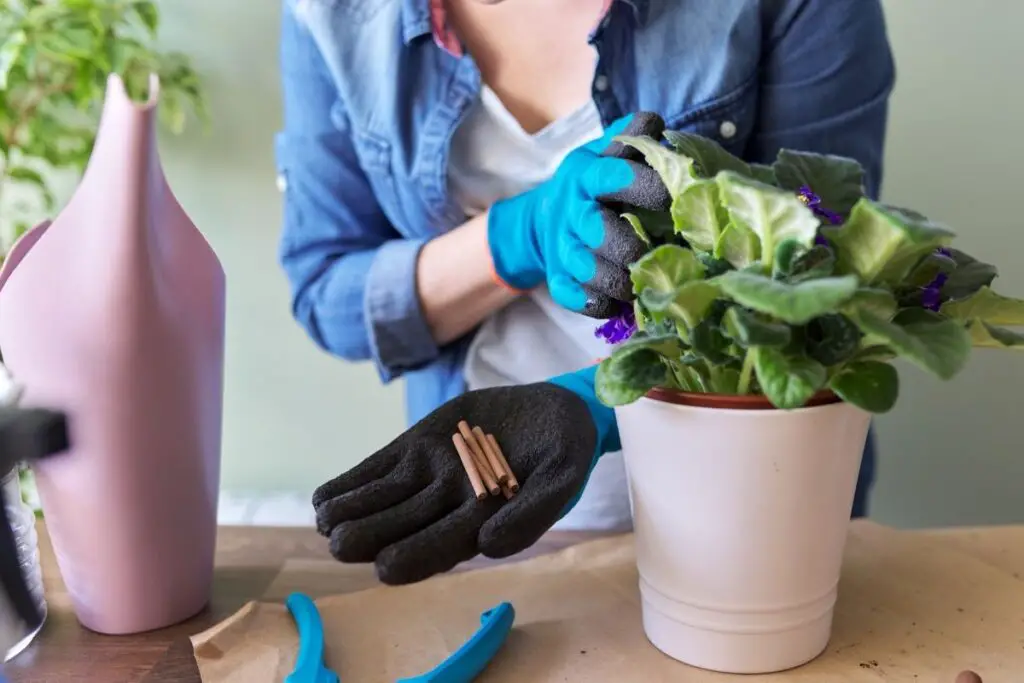
Too much fertilization can cause severe problems to African violets. These plants need little fertilizer to grow. Overfertilization can cause stunted growth and make the plant weak.
Burned or dry brown leaves are the most common symptoms of over-fertilization in African violets.
It happens because of salts in fertilizers. Salt builds up in the soil and absorbs too much water, and because of less water in the soil, it can cause water stress and dehydration in the roots.
There should be a proper balance of fertilization in plants for proper growth.
Solution
If the problem is over-fertilization, you will have to take some preventive measures to solve this issue.
- Flush the soil to remove the excess fertilizers from the soil.
- Drench the soil with water until it drains out from the bottom of the container.
- Repeat this cycle 1 to 2 times.
- Replant your African violets in a new pot with fresh organic soil.
- Always use a liquid fertilizer and add enough water to avoid over-fertilization.
Also read: What Kind Of Fertilizer Is Good For African Violets? (+Best Picks)
Low humidity
Plants need good humid conditions to grow well. Too little moisture in the air can lead to brown edges or tips on the leaves.
African violets like average humidity levels somewhere around 50 to 80%.
If the humidity goes below 50%, it will be too dry for them, and it will become difficult for African violets to survive.
It is challenging to maintain high humidity in the house. If there is a lack of humidity in the house, water will quickly evaporate from your plants, making them completely dry.
Plants predominantly experience low humidity problems during the winter month as the air becomes very dry. You need to take care of your plants during low humid conditions for healthy growth.
Solution
There are many different ways to solve the problem of low humidity conditions.
- You can use a humidifier to maintain the humidity level inside the house.
- Keeping your plants together can also increase the humidity levels between them.
- You can also create a pebble tray by putting pebbles and water in a drip tray and placing your African violet on top of the tray.
- Mist your plant by spraying water on them with a spray bottle will help in maintaining some humidity.
- Don’t place your African violets near radiators and other heating sources as in those areas where the humidity level is significantly less.
Also read: Do African Violets Like Misting? (+Humidity Guide)
Poor air circulation
Poor air circulation can affect the growth of the African violets and cause brown tips on leaves. If African violets are not getting good air circulation on the soil surface, it can stress the entire plant.
Good air circulation helps in preventing the growth of fungi in plants.
Solution
- Place your African violets in an area that has good air circulation.
- Keep your doors and windows open to provide fresh air to the African violets grown inside the house.
Root rot
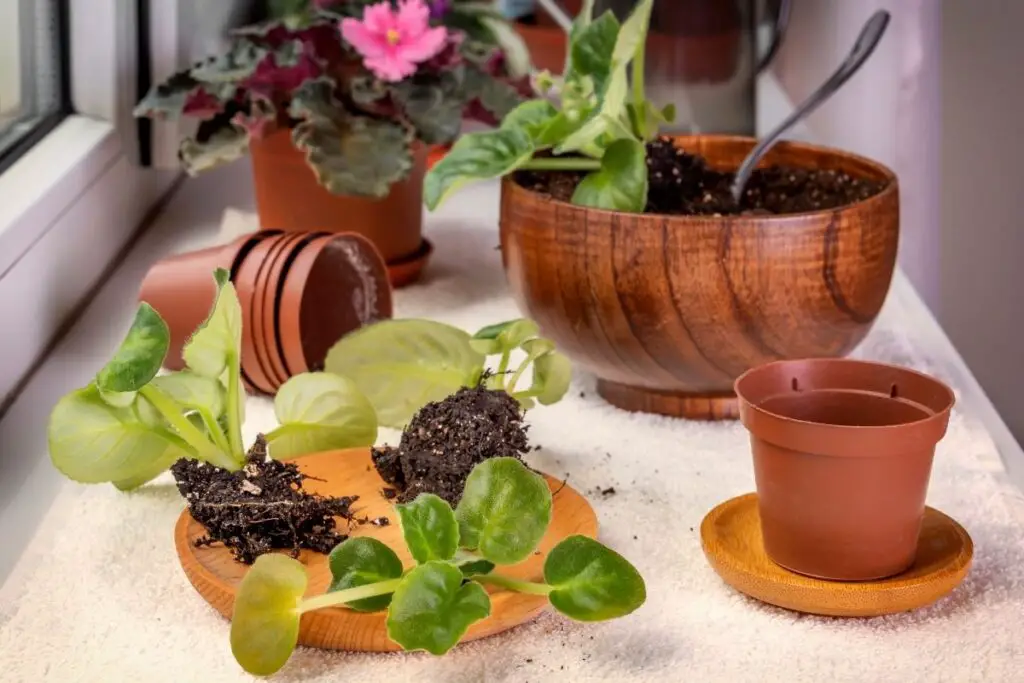
Poor drainage and overwatering are the two main reasons for root rot. Due to overwatering, various fungi and pathogens grow in the soil, which damages the roots entirely.
If your African violets are affected by root rot, the plant leaves turn brown, and they eventually fall off. Due to the wrong soil composition, African violets can undergo root rot.
Due to root rot, the plants will find difficulty in absorbing the nutrients they need. Because of this, the leaves of the plant start to wilt and turn brown.
Lack of sunlight, overwatering, and poor drainage are the three main factors contributing to this problem.
Solution
- Water your plants only if required, and make sure the soil is not soggy.
- The soil should include enough sand content to provide good drainage to prevent overwatering.
- If the roots are completely damaged, you can replant your African violets in a new pot with fresh and sterilized soil.
- If a few leaves are spotted brown, stop watering your plant for at least two weeks and provide indirect sunlight.
Pest infestations
Pests make the plants weak as they suck out the sap from them. Pests attack the plants and cause injury to them. The most common bugs of African violets are mealybugs, cyclamen mites, and thrips.
When pests are present in the plants, the leaves of African violets become spotted brown as they feed on the plant’s foliage and suck out nutrients from it.
If you notice any brown edges on the leaves of your African violets, check if they are affected by the pests or not.
Solution
If you want to get rid of the pests, you can follow the steps given below:
- Wash the African violets with a strong stream of water. All the insects start dropping on the soil surface, and they will not be able to get back on the plant after they fall off.
- To get rid of snails and slugs, you need to wash your African violets with a non-detergent soap mixture and vinegar.
- You can use pesticides like insecticide soap, horticultural oil, depending on the type of pests you are dealing with.
- Provide your plants enough air circulation and try not to keep them in humid conditions.
Also read: How To Get Rid Of Bugs On African Violets? (Signs+Treatment)
Final words
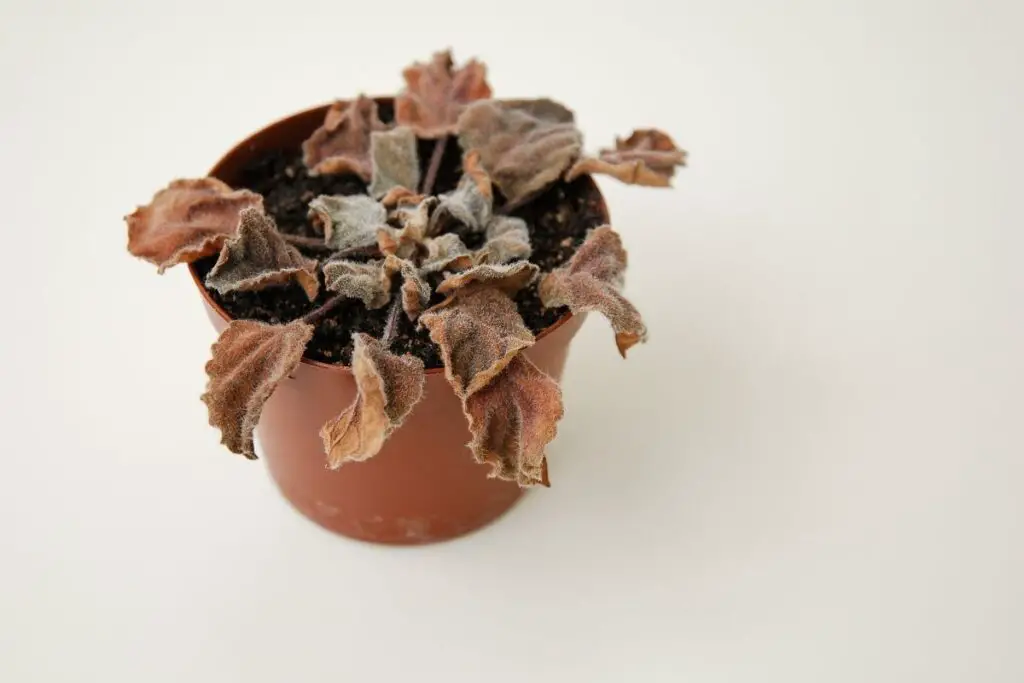
If you notice any brown edges on the leaves of your African violets, cut them off to encourage new growth. Brown leaves will not become green again, so it is better to prune the leaves.
Maintain a watering schedule for the plants and always check the moisture level of the soil before watering. It will help them to grow and stay healthy. Proper indirect sunlight will also help the plants stay healthy.
Always check for bugs in the plants and try to eliminate them as soon as possible.
Source: Wikipedia, African violet: Classical breeding, African Violet Society of America, In vitro propagation of African violet, University of Florida, North Dakota State University, The University of Georgia.
